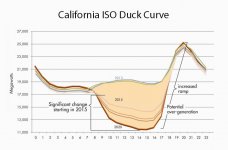GeorgeB
ElectroHydraulics engineer (retired)
- Location
- Greenville SC
- Occupation
- Retired
I don't have an EV. I don't have any EVSE at all. I do have curiosity. Let's not kill the cat.
I think I understand how circuit ampacity and OLP determine charging maxima. EVSE products often offer multiple settings, for example one may be rated up to 32 amps for use on a 40 amp circuit and have a 14-50 plug.
That same unit may be able to be set only allowing (example) 16, 20, 24, 28, or 32 amps allowing use on 20, 25, 30, 35, or 40 amp rated circuits.
HOW does it accomplish limiting? Maybe the larger question is DOES it limit, or only tell the EV over data connection to limit it? In theory, I can see how a CT, simple electronics, and thyristor(s) could do it, but ... ?
I think I understand how circuit ampacity and OLP determine charging maxima. EVSE products often offer multiple settings, for example one may be rated up to 32 amps for use on a 40 amp circuit and have a 14-50 plug.
That same unit may be able to be set only allowing (example) 16, 20, 24, 28, or 32 amps allowing use on 20, 25, 30, 35, or 40 amp rated circuits.
HOW does it accomplish limiting? Maybe the larger question is DOES it limit, or only tell the EV over data connection to limit it? In theory, I can see how a CT, simple electronics, and thyristor(s) could do it, but ... ?


